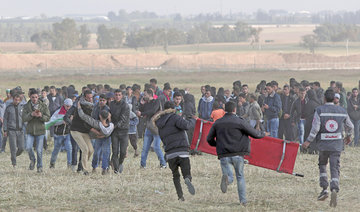JERUSALEM: Clashes erupt between Israeli police and Palestinians in September 2015 the flashpoint Al-Aqsa Mosque compound in Jerusalem’s Old City. They last three days and the unrest spreads across Jerusalem and the occupied West Bank.
• On Oct. 1, a settler couple are killed when Palestinians fire on their vehicle in the West Bank. The violence spirals as young Palestinians clash with Israeli troops and Jewish settlers, followed by a series of knife attacks targeting Israelis.
• On Oct. 9, seven young Palestinians are killed by Israeli fire during clashes at the Gaza border. Days later, following a rocket attack, Israel carries out a retaliatory raid on Gaza, killing a pregnant Palestinian woman and her daughter.
• In January, a Palestinian stabs a nurse to death in front of her children in an Israeli settlement. On Jan. 1, an Israeli Arab fires on shopfronts in Tel Aviv, killing two before being shot down.
• In June, two Palestinians fire on customers in a bustling area of the city, killing four before being arrested. Over a few days in June and July, four Palestinian attacks leave two Israelis and three attackers are killed.
• Jerusalem, bitterly disputed between Israelis and Palestinians, is the scene of frequent attacks throughout 2017.
• In January, four Israeli soldiers are killed when a Palestinian rams his truck into a group of soldiers visiting the city. The driver is killed on the spot.
• In July, three Israeli Arabs shoot dead two Israeli police officers in Jerusalem’s Old City before being shot themselves in Al-Aqsa Mosque compound. Israel, saying weapons were hidden inside the compound, bars access for two days and imposes stringent security measures, including metal detectors and surveillance cameras.
Tensions spiral into clashes between Palestinians and Israeli security forces in East Jerusalem and the West Bank. Worshippers gather for protest prayers outside the compound.
Under international pressure, Israel withdraws its metal detectors, later removing the remaining new security measures.
• On Oct. 12, members of the militant groups Islamic Jihad and Hamas are killed when Israel blows up a tunnel from Gaza into its territory.
• In December, US President Donald Trump recognizes Jerusalem as Israel’s capital in defiance of advice from world leaders, sparking outrage from Palestinians. Trump orders the transfer of the US Embassy from Tel Aviv to Jerusalem, set to take place in May 2018.
• In January, a rabbi, Raziel Shevah, is shot dead near the settlement where he lived. Three Palestinian suspects are killed. Two days later, Israeli fire kills two Palestinians in the Gaza Strip and the West Bank.
• In February, a Palestinian fatally stabs an Israeli in the West Bank and two weeks after that, two Palestinians are killed near Rafah.
• On March 16, two Israeli soldiers are killed in the West Bank in a Palestinian truck attack. A Palestinian later stabs an Israeli officer in Jerusalem’s old town, seriously injuring him before being killed.
















